Evolution towards Smart and Software-Defined Internet of Things
Abstract
:1. Introduction
Motivation
2. IoT Classification and Applications
2.1. Industrial IoT
2.2. Environmental IoT
2.3. IoT for Security Solutions
2.4. Smart Healthcare IoT
2.5. IoT for Data Analytics
2.6. Home Automation and Personal IoT
2.7. IoT for Smart Education
2.8. Heterogeneous Network IoT
2.9. IoT for Smart Waste Management
3. Smart or Cognitive IoT Architecture
3.1. Application Layer
3.2. Intelligent Low Power Interface
3.3. Intelligent Hosting Layer
3.4. Intelligent WAN Interface
3.5. Cognitive Cloud Platform-as-a-Service (PaaS)
3.6. End User
4. Smart Software-Defined IoT
4.1. Software-Defined Network
4.2. Network Functions Virtualization
4.3. Smart SDN/NFV
5. Evolution of IoT Architecture
5.1. IoT Gateway
5.2. Nanotechnology
5.3. Wireless Gateway
5.4. SDN IoT with Fog Computing
5.5. UbiFlow
5.6. Vertical and Horizontal IoT Models
5.7. Dist Block Net
5.8. 5G Technologies
6. State-of-the-Art IoT Simulators
6.1. DPWSim
6.2. iFogSim
6.3. Cooja/Contiki
6.4. NS-3
6.5. QualNet
6.6. Netsim
6.7. OMNet++
6.8. GridSim
6.9. Mininet-WiFi
7. IoT Challenges and Future Directions
7.1. Mobility and Dynamic Environment
7.2. Security and Privacy
7.3. Interoperability
7.4. Reliability
7.5. Power Consumption
8. Conclusions and Future Work
Author Contributions
Funding
Informed Consent Statement
Data Availability Statement
Conflicts of Interest
References
- Bonanni, M.; Chiti, F.; Fantacci, R.; Pierucci, L. Dynamic Control Architecture Based on Software Defined Networking for the Internet of Things. Future Internet 2021, 13, 113. [Google Scholar] [CrossRef]
- Paulson, E.N.; Yusof, K.M.; Marsono, M.N.B.; Dauda, U.S.; Kofoworola, F. Quality of Service Evaluation of Software Defined Internet of Things Network. ELEKTRIKA J. Electr. Eng. 2021, 20, 65–75. [Google Scholar] [CrossRef]
- Yang, Z.; Yue, Y.; Yang, Y.; Peng, Y.; Wang, X.; Liu, W. Study and application on the architecture and key technologies for IoT. In Proceedings of the 2011 International Conference on Multimedia Technology, Hangzhou, China, 26–28 July 2011; pp. 747–751. [Google Scholar] [CrossRef]
- Alamer, A. Security and privacy-awareness in a software-defined Fog computing network for the Internet of Things. Opt. Switch. Netw. 2021, 41, 100616. [Google Scholar] [CrossRef]
- Kiadehi, K.B.; Rahmani, A.M.; Molahosseini, A.S. Increasing fault tolerance of data plane on the internet of things using the software-defined networks. PeerJ Comput. Sci. 2021, 7, e543. [Google Scholar] [CrossRef]
- Farhan, L.; Kharel, R.; Kaiwartya, O.; Quiroz, M.; Alissa, A.; Abdulsalam, M. A Concise Review on Internet of Things (IoT)-Problems, Challenges and Opportunities. In Proceedings of the 2018 11th International Symposium on Communication Systems, Networks & Digital Signal Processing (CSNDSP), Budapest, Hungary, 18–20 July 2018. [Google Scholar] [CrossRef] [Green Version]
- Montazerolghaem, A. Software-defined Internet of Multimedia Things: Energy-efficient and Load-balanced Resource Management. IEEE Internet Things J. 2021, 9, 2432–2442. [Google Scholar] [CrossRef]
- Chen, H.; Jia, X.; Li, H. A brief introduction to IoT gateway. In Proceedings of the IET International Conference on Communication Technology and Application (ICCTA 2011), Beijing, China, 14–16 October 2011; pp. 610–613. [Google Scholar] [CrossRef]
- Liao, S.; Wu, J.; Li, J.; Bashir, A.K.; Yang, W. Securing Collaborative Environment Monitoring in Smart Cities Using Blockchain Enabled Software-Defined Internet of Drones. IEEE Internet Things Mag. 2021, 4, 12–18. [Google Scholar] [CrossRef]
- Ojo, M.; Adami, D.; Giordano, S. A SDN-IoT Architecture with NFV Implementation. In Proceedings of the 2016 IEEE Globecom Workshops (GC Wkshps), Washington, DC, USA, 4–8 December 2016; pp. 1–6. [Google Scholar] [CrossRef]
- Al-Fuqaha, A.; Guizani, M.; Mohammadi, M.; Aledhari, M.; Ayyash, M. Internet of Things: A Survey on Enabling Technologies, Protocols, and Applications. IEEE Commun. Surv. Tutor. 2015, 17, 2347–2376. [Google Scholar] [CrossRef]
- Flauzac, O.; González, C.; Hachani, A.; Nolot, F. SDN Based Architecture for IoT and Improvement of the Security. In Proceedings of the 2015 IEEE 29th International Conference on Advanced Information Networking and Applications Workshops, Gwangju, Korea, 24–27 March 2015; pp. 688–693. [Google Scholar] [CrossRef]
- Zarca, A.M.; Bernabe, J.B.; Trapero, R.; Rivera, D.; Villalobos, J.; Skarmeta, A.; Bianchi, S.; Zafeiropoulos, A.; Gouvas, P. Security Management Architecture for NFV/SDN-aware IoT Systems. IEEE Internet Things J. 2019, 6, 8005–8020. [Google Scholar] [CrossRef]
- Radoglou Grammatikis, P.; Sarigiannidis, P.; Moscholios, I. Securing the Internet of Things: Challenges, Threats and Solutions. Internet Things 2019, 5, 41–70. [Google Scholar] [CrossRef]
- Restuccia, F.; D’Oro, S.; Melodia, T. Securing the Internet of Things in the Age of Machine Learning and Software-Defined Networking. IEEE Internet Things J. 2018, 5, 4829–4842. [Google Scholar] [CrossRef] [Green Version]
- Liu, Y.; Kuang, Y.; Xiao, Y.; Xu, G. SDN-Based Data Transfer Security for Internet of Things. IEEE Internet Things J. 2018, 5, 257–268. [Google Scholar] [CrossRef]
- Mouradian, C.; Jahromi, N.T.; Glitho, R.H. NFV and SDN-Based Distributed IoT Gateway for Large-Scale Disaster Management. IEEE Internet Things J. 2018, 5, 4119–4131. [Google Scholar] [CrossRef] [Green Version]
- Ren, W.; Sun, Y.; Luo, H.; Guizani, M. A Novel Control Plane Optimization Strategy for Important Nodes in SDN-IoT Networks. IEEE Internet Things J. 2019, 6, 3558–3571. [Google Scholar] [CrossRef]
- Alberti, A.M.; Scarpioni, G.D.; Magalhães, V.J.; Cerqueira, S.A.; Rodrigues, J.J.P.C.; da Rosa Righi, R. Advancing NovaGenesis Architecture towards Future Internet of Things. IEEE Internet Things J. 2019, 6, 215–229. [Google Scholar] [CrossRef]
- Qian, Y.; Wu, D.; Bao, W.; Lorenz, P. The Internet of Things for Smart Cities: Technologies and Applications. IEEE Netw. 2019, 33, 4–5. [Google Scholar] [CrossRef]
- Shabir, B.; Khan, M.; Rahman, A.; Malik, A.; Wahid, A. Congestion avoidance in vehicular networks: A contemporary survey. IEEE Access 2019, 7, 173196–173215. [Google Scholar] [CrossRef]
- Qian, L.P.; Wu, Y.; Ji, B.; Huang, L.; Tsang, D.H.K. HybridIoT: Integration of Hierarchical Multiple Access and Computation Offloading for IoT-Based Smart Cities. IEEE Netw. 2019, 33, 6–13. [Google Scholar] [CrossRef]
- Zhao, L.; Wang, J.; Liu, J.; Kato, N. Optimal Edge Resource Allocation in IoT-Based Smart Cities. IEEE Netw. 2019, 33, 30–35. [Google Scholar] [CrossRef]
- Khattak, H.A.; Farman, H.; Jan, B.; Din, I.U. Toward Integrating Vehicular Clouds with IoT for Smart City Services. IEEE Netw. 2019, 33, 65–71. [Google Scholar] [CrossRef]
- Khan, M.A.; Khan, M.A.; Rahman, A.U.; Malik, A.W.; Khan, S.A. Exploiting cooperative sensing for accurate target tracking in industrial Internet of things. Int. J. Distrib. Sens. Netw. 2019, 15, 1550147719892203. [Google Scholar] [CrossRef] [Green Version]
- Fan, K.; Zhu, S.; Zhang, K.; Li, H.; Yang, Y. A Lightweight Authentication Scheme for Cloud-Based RFID Healthcare Systems. IEEE Netw. 2019, 33, 44–49. [Google Scholar] [CrossRef]
- Martinez, B.; Cano, C.; Vilajosana, X. A Square Peg in a Round Hole: The Complex Path for Wireless in the Manufacturing Industry. IEEE Commun. Mag. 2019, 57, 109–115. [Google Scholar] [CrossRef] [Green Version]
- Bhagat, M.; Kumar, D.; Kumar, D. Role of Internet of Things (IoT) in Smart Farming: A Brief Survey. In Proceedings of the 2019 Devices for Integrated Circuit (DevIC), Kalyani, India, 23–24 March 2019; pp. 141–145. [Google Scholar] [CrossRef]
- Hu, Z.; Bai, Z.; Yang, Y.; Zheng, Z.; Bian, K.; Song, L. UAV Aided Aerial-Ground IoT for Air Quality Sensing in Smart City: Architecture, Technologies, and Implementation. IEEE Netw. 2019, 33, 14–22. [Google Scholar] [CrossRef] [Green Version]
- Wu, F.; Rüdiger, C.; Yuce, M.R. Real-time performance of a self-powered environmental IoT sensor network system. Sensors 2017, 17, 282. [Google Scholar] [CrossRef] [PubMed] [Green Version]
- Talavera, J.M.; Tobón, L.E.; Gómez, J.A.; Culman, M.A.; Aranda, J.M.; Parra, D.T.; Quiroz, L.A.; Hoyos, A.; Garreta, L.E. Review of IoT applications in agro-industrial and environmental fields. Comput. Electron. Agric. 2017, 142, 283–297. [Google Scholar] [CrossRef]
- Hart, J.K.; Martinez, K. Toward an environmental Internet of Things. Earth Space Sci. 2015, 2, 194–200. [Google Scholar] [CrossRef] [Green Version]
- Mois, G.; Folea, S.; Sanislav, T. Analysis of three IoT-based wireless sensors for environmental monitoring. IEEE Trans. Instrum. Meas. 2017, 66, 2056–2064. [Google Scholar] [CrossRef]
- García-Orellana, C.J.; Macías-Macías, M.; González-Velasco, H.M.; García-Manso, A.; Gallardo-Caballero, R. Low-power and low-cost environmental IoT electronic nose using initial action period measurements. Sensors 2019, 19, 3183. [Google Scholar] [CrossRef] [Green Version]
- Elmisery, A.M.; Sertovic, M.; Gupta, B.B. Cognitive privacy middleware for deep learning mashup in environmental IoT. IEEE Access 2017, 6, 8029–8041. [Google Scholar] [CrossRef]
- Ometov, A.; Petrov, V.; Bezzateev, S.; Andreev, S.; Koucheryavy, Y.; Gerla, M. Challenges of Multi-Factor Authentication for Securing Advanced IoT Applications. IEEE Netw. 2019, 33, 82–88. [Google Scholar] [CrossRef]
- Ni, J.; Lin, X.; Shen, X.S. Toward Edge-Assisted Internet of Things: From Security and Efficiency Perspectives. IEEE Netw. 2019, 33, 50–57. [Google Scholar] [CrossRef]
- Hassija, V.; Chamola, V.; Saxena, V.; Jain, D.; Goyal, P.; Sikdar, B. A Survey on IoT Security: Application Areas, Security Threats, and Solution Architectures. IEEE Access 2019, 7, 82721–82743. [Google Scholar] [CrossRef]
- Wu, F.; Redouté, J.; Yuce, M.R. WE-Safe: A Self-Powered Wearable IoT Sensor Network for Safety Applications Based on LoRa. IEEE Access 2018, 6, 40846–40853. [Google Scholar] [CrossRef]
- Vippalapalli, V.; Ananthula, S. Internet of things (IoT) based smart health care system. In Proceedings of the 2016 International Conference on Signal Processing, Communication, Power and Embedded System (SCOPES), Paralakhemundi, India, 3–5 October 2016; pp. 1229–1233. [Google Scholar] [CrossRef]
- Sun, Y.; Song, H.; Jara, A.J.; Bie, R. Internet of Things and Big Data Analytics for Smart and Connected Communities. IEEE Access 2016, 4, 766–773. [Google Scholar] [CrossRef]
- Shah, S.A.; Seker, D.Z.; Hameed, S.; Draheim, D. The Rising Role of Big Data Analytics and IoT in Disaster Management: Recent Advances, Taxonomy and Prospects. IEEE Access 2019, 7, 54595–54614. [Google Scholar] [CrossRef]
- Akbar, A.; Kousiouris, G.; Pervaiz, H.; Sancho, J.; Ta-Shma, P.; Carrez, F.; Moessner, K. Real-Time Probabilistic Data Fusion for Large-Scale IoT Applications. IEEE Access 2018, 6, 10015–10027. [Google Scholar] [CrossRef]
- Akbar, A.; Khan, A.; Carrez, F.; Moessner, K. Predictive Analytics for Complex IoT Data Streams. IEEE Internet Things J. 2017, 4, 1571–1582. [Google Scholar] [CrossRef] [Green Version]
- Zhu, Z.T.; Yu, M.H.; Riezebos, P. A research framework of smart education. Smart Learn. Environ. 2016, 3, 1–17. [Google Scholar] [CrossRef] [Green Version]
- Ma, H.; Liu, L.; Zhou, A.; Zhao, D. On Networking of Internet of Things: Explorations and Challenges. IEEE Internet Things J. 2016, 3, 441–452. [Google Scholar] [CrossRef]
- Salwe, S.S.; Naik, K.K. Heterogeneous Wireless Network for IoT Applications. IETE Tech. Rev. 2019, 36, 61–68. [Google Scholar] [CrossRef]
- Kaiwartya, O.; Abdullah, A.H.; Cao, Y.; Altameem, A.; Prasad, M.; Lin, C.; Liu, X. Internet of Vehicles: Motivation, Layered Architecture, Network Model, Challenges, and Future Aspects. IEEE Access 2016, 4, 5356–5373. [Google Scholar] [CrossRef]
- Hong, I.; Park, S.; Lee, B.; Jeong, D.; Park, S. IoT-Based Smart Garbage System for Efficient Food Waste Management. Sci. World J. 2014, 2014, 646953. [Google Scholar] [CrossRef]
- Ojo, M.O.; Giordano, S.; Procissi, G.; Seitanidis, I.N. A Review of Low-End, Middle-End, and High-End IoT Devices. IEEE Access 2018, 6, 70528–70554. [Google Scholar] [CrossRef]
- Bello, O.; Zeadally, S. Intelligent Device-to-Device Communication in the Internet of Things. IEEE Syst. J. 2016, 10, 1172–1182. [Google Scholar] [CrossRef]
- Sethi, P.; Sarangi, S.R. Internet of things: Architectures, protocols, and applications. J. Electr. Comput. Eng. 2017, 2017. [Google Scholar] [CrossRef] [Green Version]
- Chaqfeh, M.A.; Mohamed, N. Challenges in middleware solutions for the internet of things. In Proceedings of the 2012 International Conference on Collaboration Technologies and Systems (CTS), Denver, CO, USA, 21–25 May 2012; pp. 21–26. [Google Scholar] [CrossRef]
- Tongke, F. Smart Agriculture Based on Cloud Computing and IoT. J. Converg. Inf. Technol. 2013, 8, 210–216. [Google Scholar]
- Gubbi, J.; Buyya, R.; Marusic, S.; Palaniswami, M. Internet of Things (IoT): A vision, architectural elements, and future directions. Future Gener. Comput. Syst. 2013, 29, 1645–1660. [Google Scholar] [CrossRef] [Green Version]
- Lee, H.; Ke, K. Monitoring of Large-Area IoT Sensors Using a LoRa Wireless Mesh Network System: Design and Evaluation. IEEE Trans. Instrum. Meas. 2018, 67, 2177–2187. [Google Scholar] [CrossRef]
- Fekade, B.; Maksymyuk, T.; Kyryk, M.; Jo, M. Probabilistic Recovery of Incomplete Sensed Data in IoT. IEEE Internet Things J. 2018, 5, 2282–2292. [Google Scholar] [CrossRef]
- Bera, S.; Misra, S.; Vasilakos, A.V. Software-Defined Networking for Internet of Things: A Survey. IEEE Internet Things J. 2017, 4, 1994–2008. [Google Scholar] [CrossRef]
- Qin, Z.; Denker, G.; Giannelli, C.; Bellavista, P.; Venkatasubramanian, N. A Software Defined Networking architecture for the Internet-of-Things. In Proceedings of the 2014 IEEE Network Operations and Management Symposium (NOMS), Krakow, Poland, 5–9 May 2014; pp. 1–9. [Google Scholar] [CrossRef] [Green Version]
- Jararweh, Y.; Al-Ayyoub, M.; Darabseh, A.; Benkhelifa, E.; Vouk, M.; Rindos, A. SDIoT: A software defined based internet of things framework. J. Ambient. Intell. Humaniz. Comput. 2015, 6, 453–461. [Google Scholar] [CrossRef]
- Ordonez-Lucena, J.; Ameigeiras, P.; Lopez, D.; Ramos-Munoz, J.J.; Lorca, J.; Folgueira, J. Network Slicing for 5G with SDN/NFV: Concepts, Architectures, and Challenges. IEEE Commun. Mag. 2017, 55, 80–87. [Google Scholar] [CrossRef] [Green Version]
- Tello-Oquendo, L.; Akyildiz, I.F.; Lin, S.; Pla, V. SDN-based architecture for providing reliable Internet of Things connectivity in 5G systems. In Proceedings of the 2018 17th Annual Mediterranean Ad Hoc Networking Workshop (Med-Hoc-Net), Capri Island, Italy, 20–22 June 2018; pp. 1–8. [Google Scholar] [CrossRef] [Green Version]
- Ma, L.; Wen, X.; Wang, L.; Lu, Z.; Knopp, R. An SDN/NFV based framework for management and deployment of service based 5G core network. China Commun. 2018, 15, 86–98. [Google Scholar] [CrossRef]
- Akhtar, M.W.; Hassan, S.A.; Ghaffar, R.; Jung, H.; Garg, S.; Hossain, M.S. The shift to 6G communications: Vision and requirements. Hum.-Centric Comput. Inf. Sci. 2020, 10, 1–27. [Google Scholar] [CrossRef]
- Akhtar, M.W.; Hassan, S.A.; Mahmood, A.; Jung, H.; Qureshi, H.K.; Gidlund, M. Q2A-NOMA: A Q-Learning-based QoS-Aware NOMA System Design for Diverse Data Rate Requirements. IEEE Trans. Ind. Inform. 2022, 1–10. [Google Scholar] [CrossRef]
- Sinh, D.; Le, L.; Lin, B.P.; Tung, L. SDN/NFV—A new approach of deploying network infrastructure for IoT. In Proceedings of the 2018 27th Wireless and Optical Communication Conference (WOCC), Hualien, Taiwan, 30 April–1 May 2018; pp. 1–5. [Google Scholar] [CrossRef]
- Azzouz, L.; Jamai, I. SDN, slicing, and NFV paradigms for a smart home: A comprehensive survey. Trans. Emerg. Telecommun. Technol. 2019, 30, e3744. [Google Scholar] [CrossRef]
- Alam, I.; Sharif, K.; Li, F.; Latif, Z.; Karim, M.M.; Biswas, S.; Nour, B.; Wang, Y. A Survey of Network Virtualization Techniques for Internet of Things Using SDN and NFV. ACM Comput. Surv. 2020, 53, 1–40. [Google Scholar] [CrossRef]
- Guinard, D.; Trifa, V.; Wilde, E. A resource oriented architecture for the Web of Things. In Proceedings of the 2010 Internet of Things (IoT), Tokyo, Japan, 29 November–1 December 2010; pp. 1–8. [Google Scholar] [CrossRef]
- Zorzi, M.; Gluhak, A.; Lange, S.; Bassi, A. From today’s INTRAnet of things to a future INTERnet of things: A wireless- and mobility-related view. IEEE Wirel. Commun. 2010, 17, 44–51. [Google Scholar] [CrossRef]
- Chase, J. The evolution of the internet of things. Tex. Instrum. 2013, 1, 1–7. [Google Scholar]
- Saravanan, K.; Julie, E.G.; Robinson, Y.H. Smart cities & IoT: Evolution of applications, architectures & technologies, present scenarios & future dream. In Internet of Things and Big Data Analytics for Smart Generation; Springer: Cham, Switzerland, 2019; pp. 135–151. [Google Scholar]
- Miron-alexe, V. IoT Power Consumption Monitoring System for Off-Grid Households. Univ. Pitesti Sci. Bull. Ser. Electron. Comput. Sci. 2017, 17, 13–20. [Google Scholar]
- Chen, D.; Chang, G.; Jin, L.; Ren, X.; Li, J.; Li, F. A Novel Secure Architecture for the Internet of Things. In Proceedings of the 2011 Fifth International Conference on Genetic and Evolutionary Computing, Kitakyushu, Japan, 29 August–1 September 2011; pp. 311–314. [Google Scholar] [CrossRef]
- Kosmatos, E.; Tselikas, N.; Boucouvalas, A. Integrating RFIDs and Smart Objects into a Unified Internet of Things Architecture. Adv. Internet Things 2011, 1, 5–12. [Google Scholar] [CrossRef] [Green Version]
- Yun, M.; Bu, Y. Research on the architecture and key technology of Internet of Things (IoT) applied on smart grid. In Proceedings of the 2010 International Conference on Advances in Energy Engineering, Beijing, China, 19–20 June 2010; pp. 69–72. [Google Scholar] [CrossRef]
- Jia, X.; Feng, Q.; Fan, T.; Lei, Q. RFID technology and its applications in Internet of Things (IoT). In Proceedings of the 2012 2nd International Conference on Consumer Electronics, Communications and Networks (CECNet), Yichang, China, 21–23 April 2012; pp. 1282–1285. [Google Scholar] [CrossRef]
- Datta, S.K.; Bonnet, C.; Nikaein, N. An IoT gateway centric architecture to provide novel M2M services. In Proceedings of the 2014 IEEE World Forum on Internet of Things (WF-IoT), Seoul, Korea, 6–8 March 2014; pp. 514–519. [Google Scholar] [CrossRef]
- Tomovic, S.; Yoshigoe, K.; Maljevic, I.; Radusinovic, I. Software-Defined Fog Network Architecture for IoT. Wirel. Pers. Commun. 2017, 92, 181–196. [Google Scholar] [CrossRef]
- Li, F.; Voegler, M.; Claessens, M.; Dustdar, S. Efficient and Scalable IoT Service Delivery on Cloud. In Proceedings of the 2013 IEEE Sixth International Conference on Cloud Computing, Santa Clara, CA, USA, 28 June–3 July 2013; pp. 740–747. [Google Scholar] [CrossRef] [Green Version]
- Wu, D.; Arkhipov, D.I.; Asmare, E.; Qin, Z.; McCann, J.A. UbiFlow: Mobility management in urban-scale software defined IoT. In Proceedings of the 2015 IEEE Conference on Computer Communications (INFOCOM), Hong Kong, China, 26 April–1 May 2015; pp. 208–216. [Google Scholar] [CrossRef] [Green Version]
- Nedeltcheva, G.N.; Shoikova, E. Models for innovative IoT ecosystems. In Proceedings of the International Conference on Big Data and Internet of Thing, London, UK, 20–22 December 2017; pp. 164–168. [Google Scholar]
- Li, Y.; Su, X.; Riekki, J.; Kanter, T.; Rahmani, R. A SDN-based architecture for horizontal Internet of Things services. In Proceedings of the 2016 IEEE International Conference on Communications (ICC), Kuala Lumpur, Malaysia, 22–27 May 2016; pp. 1–7. [Google Scholar] [CrossRef]
- Akhtar, M.W.; Hassan, S.A. TaNTIN: Terrestrial and non-terrestrial integrated networks-A collaborative technologies perspective for beyond 5G and 6G. Internet Technol. Lett. 2021, e274. [Google Scholar] [CrossRef]
- Elahi, B.; Malik, A.; Rahman, A.; Khan, M. Toward scalable cloud data center simulation using high-level architecture. Softw. Pract. Exp. 2019, 50, 827–843. [Google Scholar] [CrossRef]
- Chernyshev, M.; Baig, Z.; Bello, O.; Zeadally, S. Internet of Things (IoT): Research, Simulators, and Testbeds. IEEE Internet Things J. 2018, 5, 1637–1647. [Google Scholar] [CrossRef]
- Papadopoulos, G.Z.; Gallais, A.; Schreiner, G.; Jou, E.; Noël, T. Thorough IoT testbed Characterization: From Proof-of-concept to Repeatable Experimentations. Comput. Netw. 2017, 119, 86–101. [Google Scholar] [CrossRef] [Green Version]
- Han, S.N.; Lee, G.M.; Crespi, N.; Luong, N.V.; Heo, K.; Brut, M.; Gatellier, P. DPWSim: A Devices Profile for Web Services (DPWS) Simulator. IEEE Internet Things J. 2015, 2, 221–229. [Google Scholar] [CrossRef] [Green Version]
- Buyya, R.; Srirama, S.N. Modeling and Simulation of Fog and Edge Computing Environments Using iFogSim Toolkit. In Fog and Edge Computing: Principles and Paradigms; Wiley: Hoboken, NJ, USA, 2019; pp. 1–35. [Google Scholar] [CrossRef]
- D’Angelo, G.; Ferretti, S.; Ghini, V. Simulation of the Internet of Things. In Proceedings of the 2016 International Conference on High Performance Computing & Simulation (HPCS), Innsbruck, Austria, 18–22 July 2016; pp. 1–8. [Google Scholar] [CrossRef] [Green Version]
- Henderson; Lacage, M.; Riley, G.F. Network simulations with the ns-3 simulator. SIGCOMM Demonstr. 2008, 14, 527. [Google Scholar]
- Aireen, G.; Mohan, C.E.; Pooja, C.H.; Pooja, F.T.; Raghuram, K.M. Wireless network simulation and analysis using qualnet. In Proceedings of the 2017 2nd International Conference on Communication and Electronics Systems (ICCES), Coimbatore, India, 19–20 October 2017; pp. 251–255. [Google Scholar] [CrossRef]
- Schneider, T.; Schmidt, H. NETSIM: A Realtime Virtual Ocean Hardware-in-the-loop Acoustic Modem Network Simulator. In Proceedings of the 2018 Fourth Underwater Communications and Networking Conference (UComms), Lerici, Italy, 28–30 August 2018; pp. 1–5. [Google Scholar] [CrossRef] [Green Version]
- Varga, A.; Hornig, R. An Overview of the OMNeT++ Simulation Environment. In Proceedings of the 1st International Conference on Simulation Tools and Techniques for Communications, Networks and Systems & Workshops Simutools ’08, Marseille, France, 3–7 March 2008; Institute for Computer Sciences, Social-Informatics and Telecommunications Engineering (ICST): Brussels, Belgium, 2008; pp. 60:1–60:10. [Google Scholar]
- Chou, C.; Yang, S.C. EstiNet openflow network simulator and emulator. IEEE Commun. Mag. 2013, 51, 110–117. [Google Scholar]
- Rawat, P.S.; Yadav, A.K.; Barthwal, V. Grid resource computing environment simulation using GridSim toolkit. In Proceedings of the 2015 2nd International Conference on Computing for Sustainable Global Development (INDIACom), New Delhi, India, 11–13 March 2015; pp. 1069–1073. [Google Scholar]
- Fontes, R.R.; Afzal, S.; Brito, S.H.B.; Santos, M.A.S.; Rothenberg, C.E. Mininet-WiFi: Emulating software-defined wireless networks. In Proceedings of the 2015 11th International Conference on Network and Service Management (CNSM), Barcelona, Spain, 9–13 November 2015; pp. 384–389. [Google Scholar] [CrossRef]
- Alam, K.M.; Saini, M.; Saddik, A.E. Toward Social Internet of Vehicles: Concept, Architecture, and Applications. IEEE Access 2015, 3, 343–357. [Google Scholar] [CrossRef]
- Ang, L.; Seng, K.P.; Ijemaru, G.K.; Zungeru, A.M. Deployment of IoV for Smart Cities: Applications, Architecture, and Challenges. IEEE Access 2019, 7, 6473–6492. [Google Scholar] [CrossRef]
- Yang, Q.; Lu, R.; Rong, C.; Challal, Y.; Laurent, M.; Wang, S. Guest Editorial The Convergence of Blockchain and IoT: Opportunities, Challenges and Solutions. IEEE Internet Things J. 2019, 6, 4556–4560. [Google Scholar] [CrossRef]
- Noura, M.; Atiquzzaman, M.; Gaedke, M. Interoperability in Internet of Things: Taxonomies and Open Challenges. Mob. Netw. Appl. 2019, 24, 796–809. [Google Scholar] [CrossRef] [Green Version]
- Han, Y.; Lang, Y.; Cheng, M.; Geng, Z.; Chen, G.; Xia, T. DTaxa: An actor–critic for automatic taxonomy induction. Eng. Appl. Artif. Intell. 2021, 106, 104501. [Google Scholar] [CrossRef]
- Liu, X.; Ansari, N. Toward Green IoT: Energy Solutions and Key Challenges. IEEE Commun. Mag. 2019, 57, 104–110. [Google Scholar] [CrossRef]
- Han, Y.; Li, J.; Lou, X.; Fan, C.; Geng, Z. Energy saving of buildings for reducing carbon dioxide emissions using novel dendrite net integrated adaptive mean square gradient. Appl. Energy 2022, 309, 118409. [Google Scholar] [CrossRef]
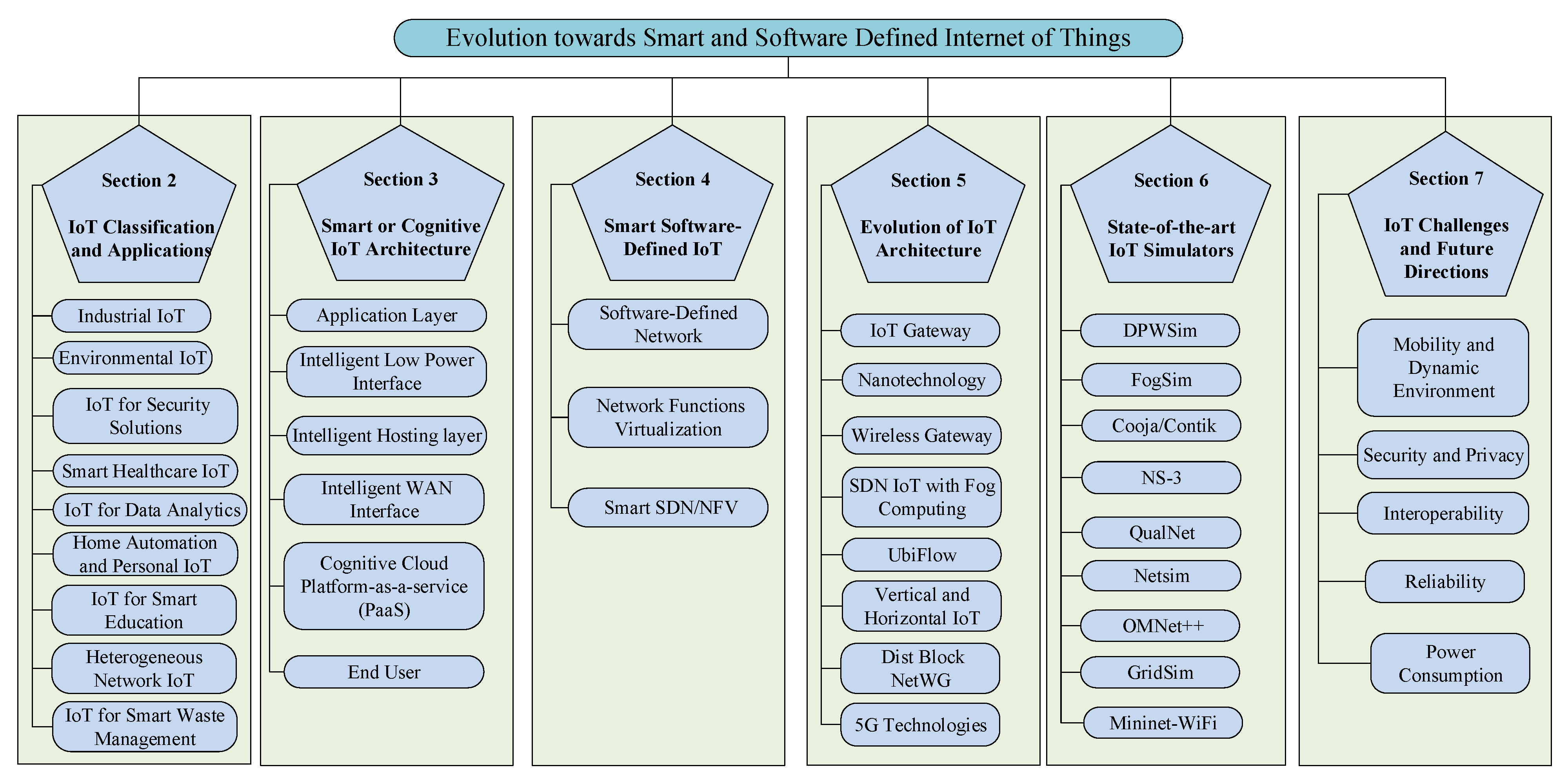
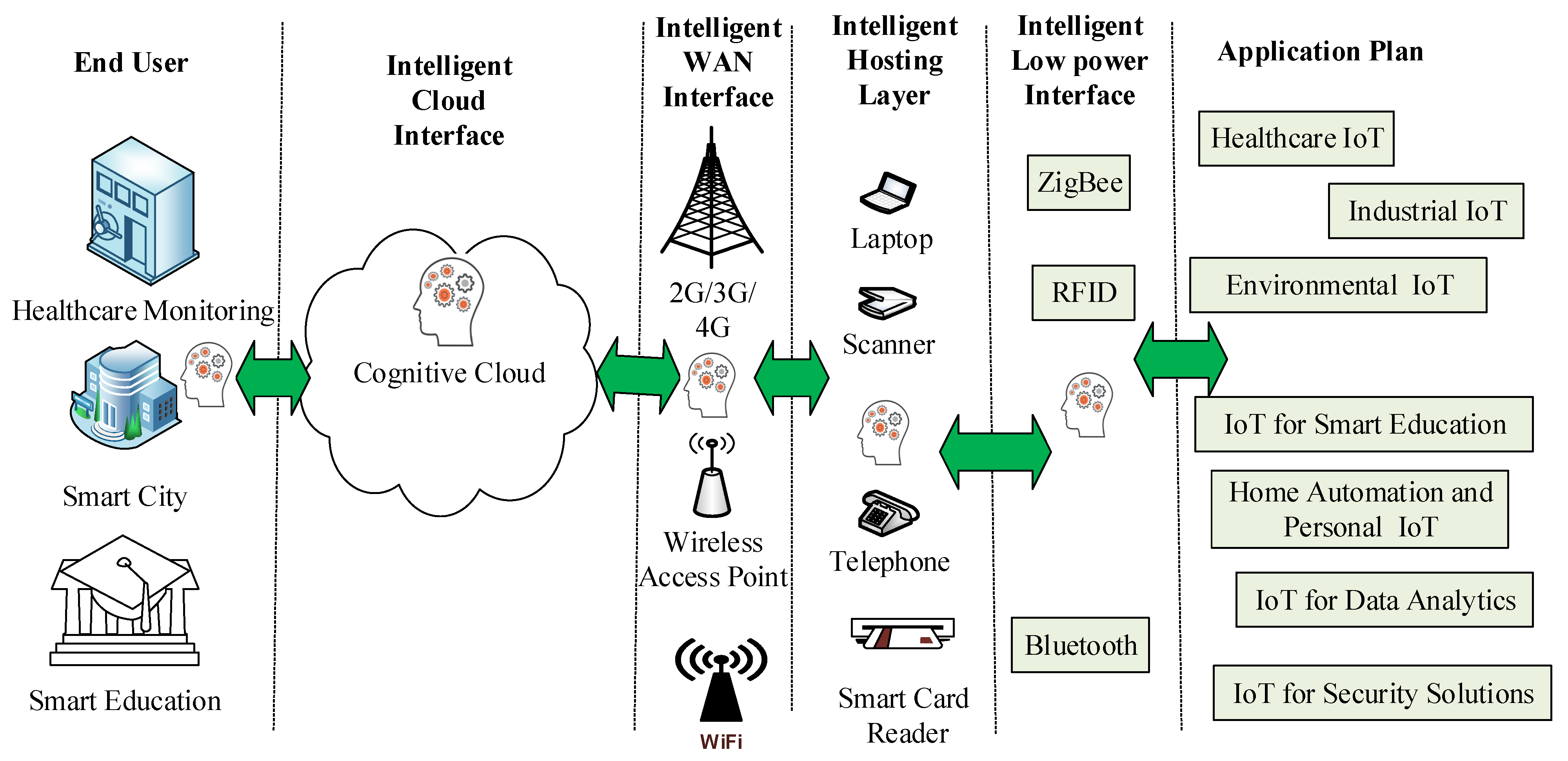
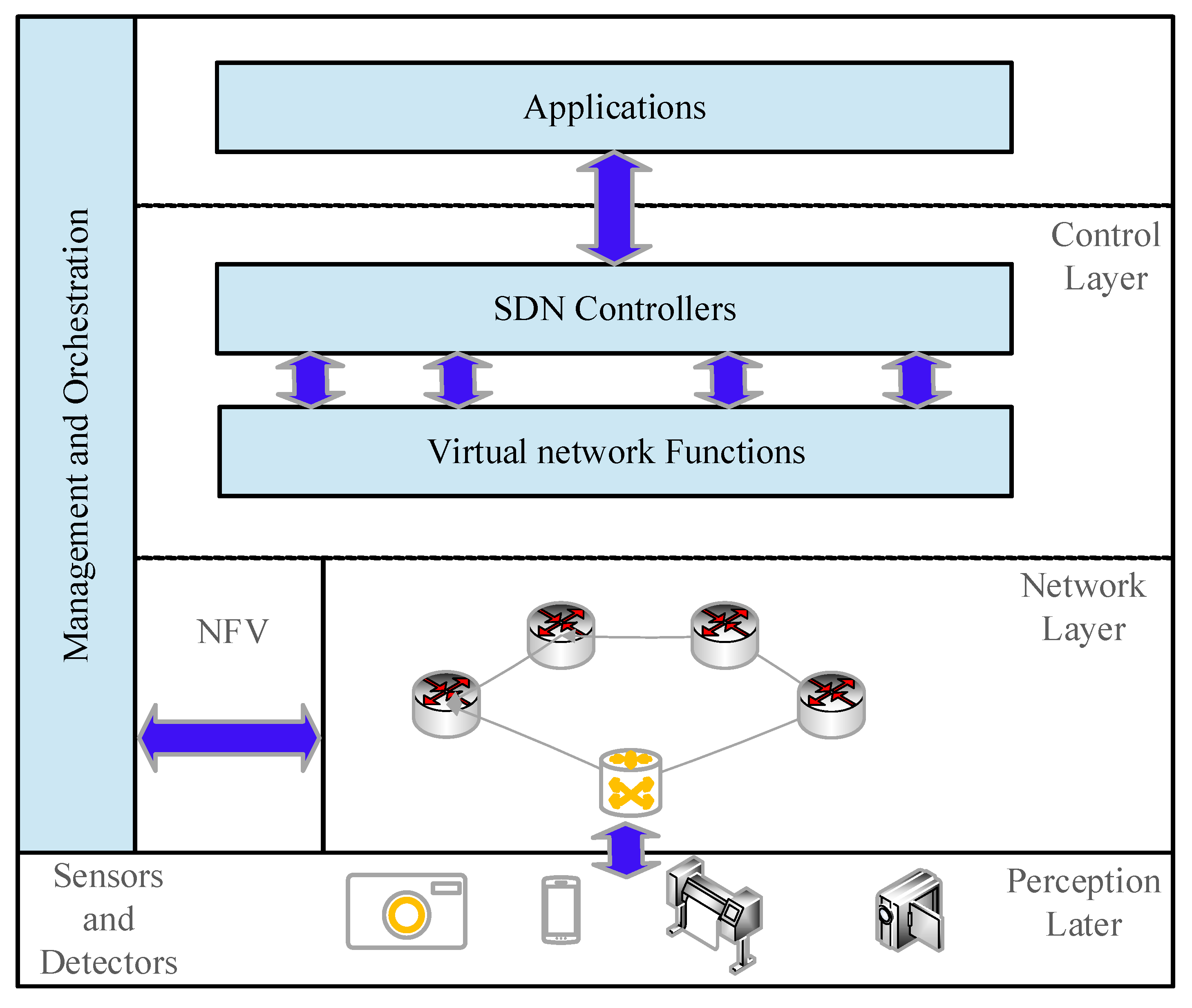

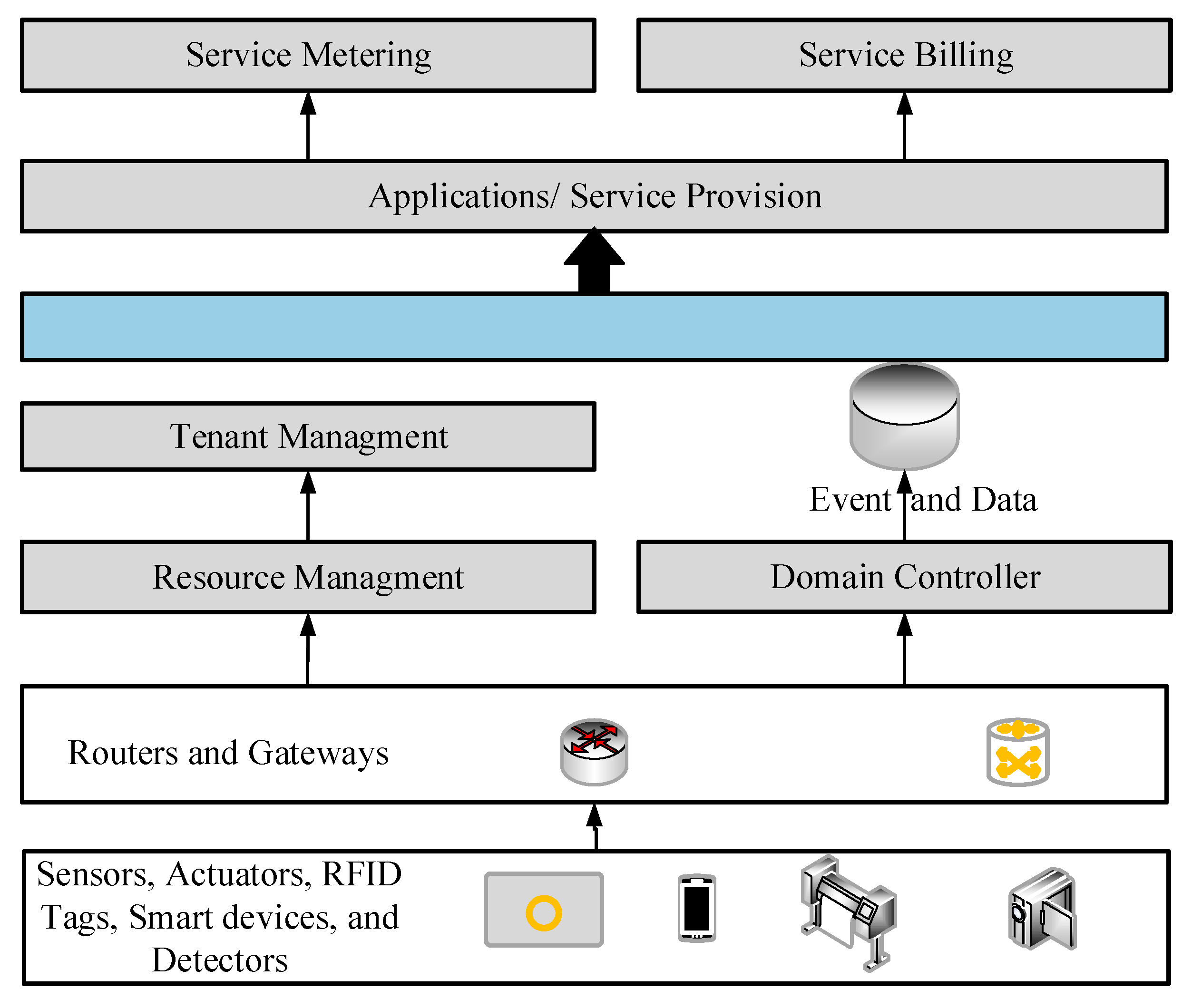
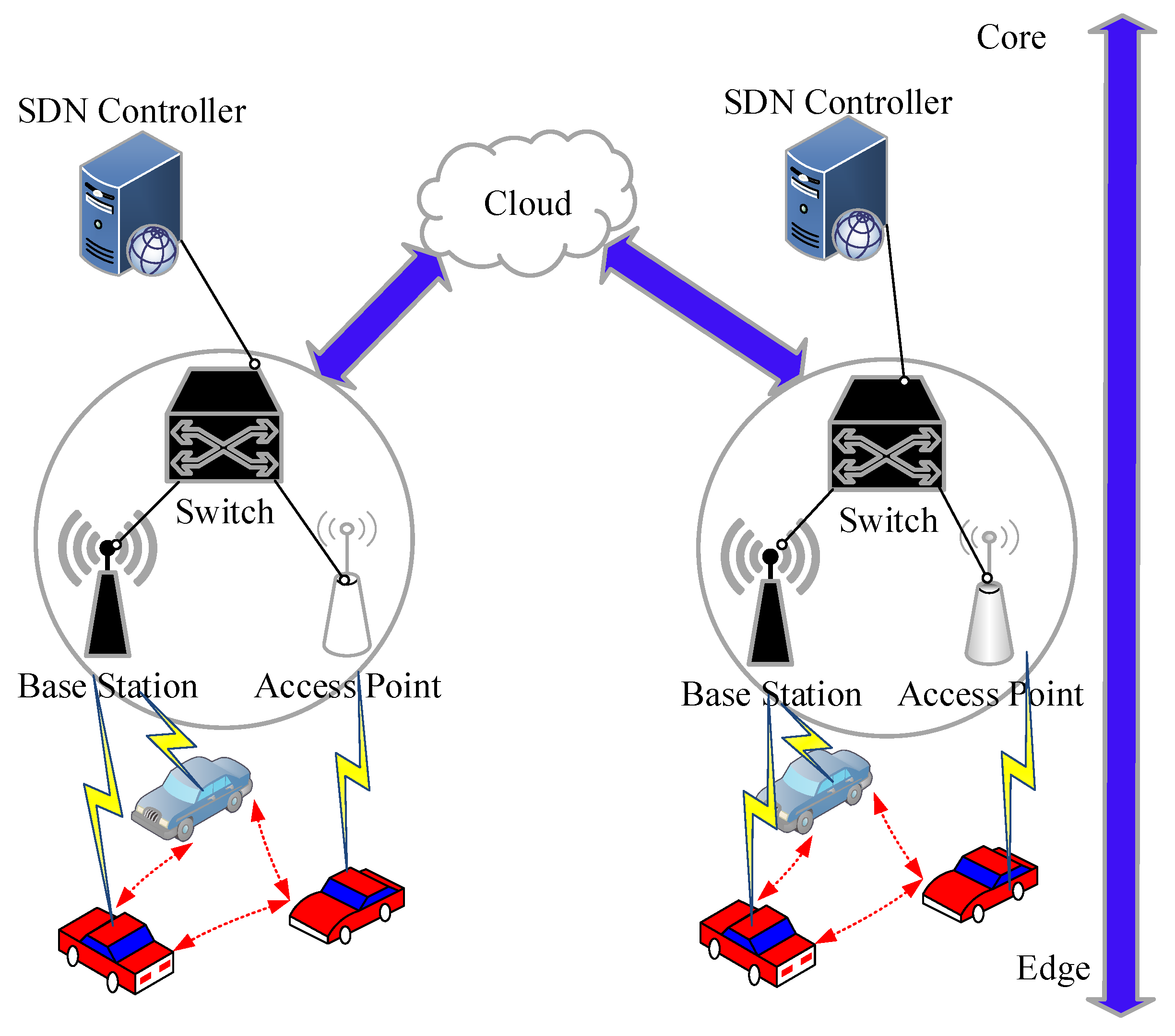
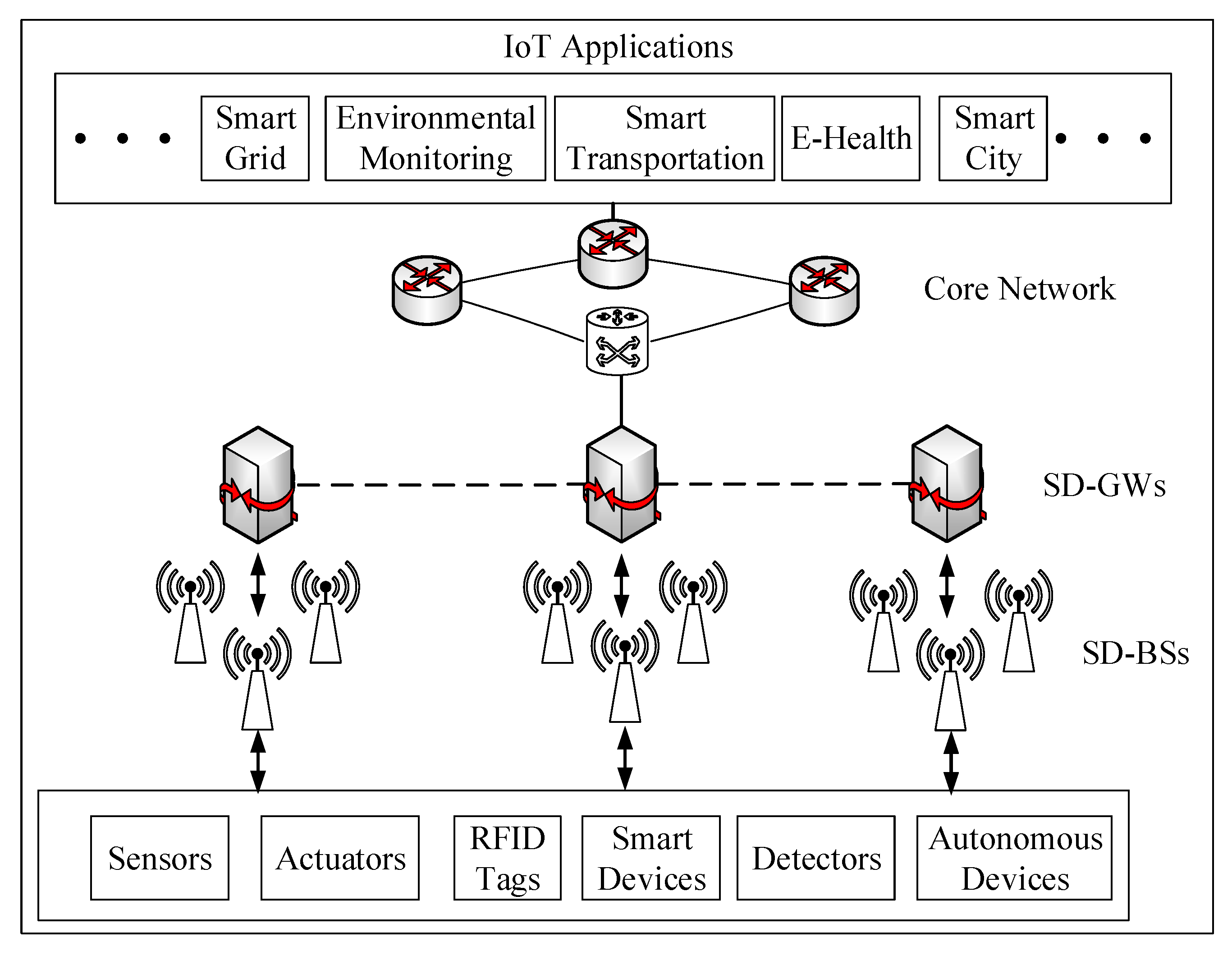
| Approach | Technology | IOP | SP | Scal. | QoS | EES | Vir. | Het. | R | M | St. | MT |
|---|---|---|---|---|---|---|---|---|---|---|---|---|
| IOT Gateway | IoT | PC | PC | N | NA | NA | N | PC | NA | NA | NA | NA |
| Nanotechnology | IoT | PC | N | PC | NA | NA | N | PC | NA | NA | NA | NA |
| Task Computing Framework | IoT | PC | N | N | NA | NA | N | N | NA | NA | NA | NA |
| Tripple Based Distributed | IoT | PC | PC | N | NA | NA | N | N | NA | NA | NA | NA |
| UBIWARE | IoT | PC | N | NA | NA | NA | N | PC | NA | PC | N | NA |
| SOA | IoT | PC | PC | PC | NA | NA | N | PC | NA | NA | PC | NA |
| GSN | IoT | PC | N | PC | NA | NA | N | PC | NA | NA | NA | NA |
| Fosstrak | IoT | N | N | N | NA | NA | N | PC | NA | NA | PC | NA |
| TinyREST | IoT | PC | N | N | NA | NA | N | N | NA | NA | NA | NA |
| ROS | IoT | PC | PC | NA | NA | NA | N | PC | NA | NA | NA | NA |
| WSO2 Stratos | IoT/PaaS | PC | NA | PC | NA | NA | N | PC | NA | NA | NA | PC |
| Wireless Gateway (WG) | IoT | PC | NA | PC | NA | NA | N | PC | NA | NA | NA | NA |
| Smart Garbage Bin (SGB) | IoT | PC | PC | PC | NA | NA | N | N | PC | PC | NA | NA |
| Approach | Technology | IOP | SP | Scal | QoS | EES | Vir. | Het. | DRU | SI | NS | MT | ACD | AI |
|---|---|---|---|---|---|---|---|---|---|---|---|---|---|---|
| MINA | SDN | PC | PC | PC | PC | NA | N | FC | PC | NA | N | N | N | N |
| SDIoT | SDN | PC | PC | PC | NA | NA | Y | FC | PC | NA | N | N | N | N |
| UbiFlow | SDN | PC | PC | FC | PC | PC | N | FC | FC | Y | N | N | N | N |
| Horizontal IoT | SDN | FC | PC | FC | NA | N | N | FC | FC | NA | N | N | N | N |
| IIoT SDN | SDN | PC | PC | FC | NA | NA | N | PC | PC | NA | N | N | N | N |
| SDN IoT with FOG | SDN/FOG | PC | PC | FC | FC | N | N | FC | FC | NA | N | N | N | N |
| DiskBlockNet | SDN/Blockchain | PC | FC | FC | NA | N | N | PC | NA | NA | N | N | N | N |
| SDN IoT with NFV | SDN/NFV | PC | PC | FC | FC | FC | Y | FC | FC | Y | NA | NA | N | N |
| Softair | SDN/NFV | PC | PC | FC | FC | FC | Y | FC | FC | Y | Y | Y | N | N |
| Full SDMN with NFV | SDN/NFV | PC | FC | FC | FC | FC | Y | FC | FC | NA | Y | Y | N | N |
Publisher’s Note: MDPI stays neutral with regard to jurisdictional claims in published maps and institutional affiliations. |
© 2022 by the authors. Licensee MDPI, Basel, Switzerland. This article is an open access article distributed under the terms and conditions of the Creative Commons Attribution (CC BY) license (https://creativecommons.org/licenses/by/4.0/).
Share and Cite
Abid, M.A.; Afaqui, N.; Khan, M.A.; Akhtar, M.W.; Malik, A.W.; Munir, A.; Ahmad, J.; Shabir, B. Evolution towards Smart and Software-Defined Internet of Things. AI 2022, 3, 100-123. https://doi.org/10.3390/ai3010007
Abid MA, Afaqui N, Khan MA, Akhtar MW, Malik AW, Munir A, Ahmad J, Shabir B. Evolution towards Smart and Software-Defined Internet of Things. AI. 2022; 3(1):100-123. https://doi.org/10.3390/ai3010007
Chicago/Turabian StyleAbid, Muhammad Aneeq, Naokhaiz Afaqui, Muazzam A. Khan, Muhammad Waseem Akhtar, Asad Waqar Malik, Arslan Munir, Jawad Ahmad, and Balawal Shabir. 2022. "Evolution towards Smart and Software-Defined Internet of Things" AI 3, no. 1: 100-123. https://doi.org/10.3390/ai3010007
APA StyleAbid, M. A., Afaqui, N., Khan, M. A., Akhtar, M. W., Malik, A. W., Munir, A., Ahmad, J., & Shabir, B. (2022). Evolution towards Smart and Software-Defined Internet of Things. AI, 3(1), 100-123. https://doi.org/10.3390/ai3010007









